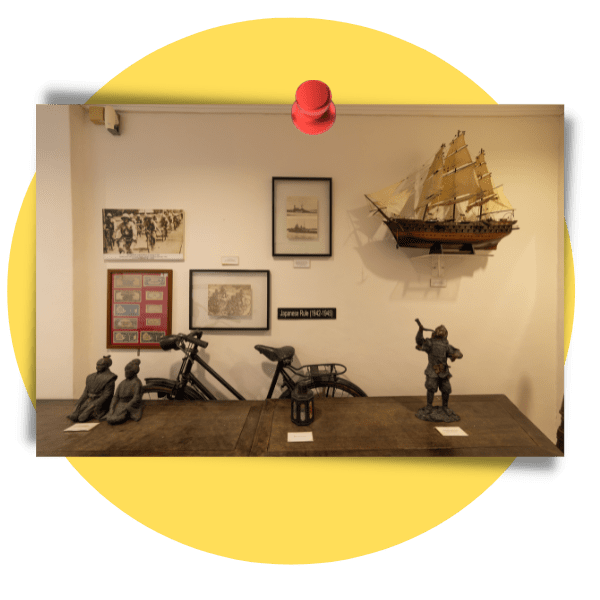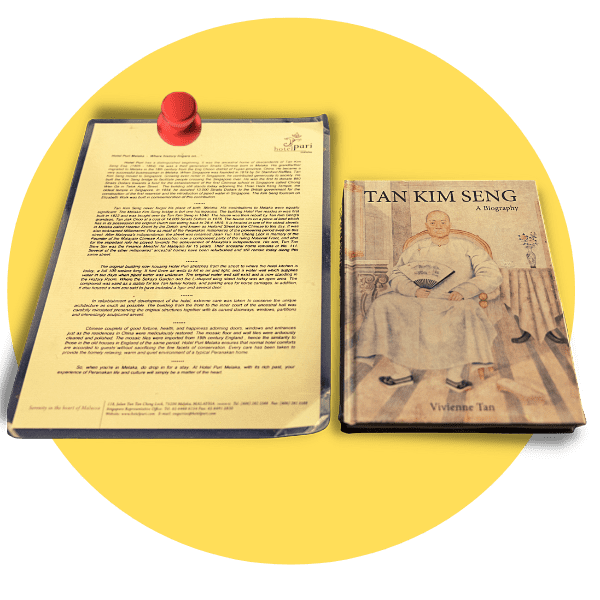OUR HISTORY
Hotel Puri has a distinguished beginning. It was the ancestral home of the descendants of Tan Kim Seng (1805-1864). He was a third generation Straits Chinese born in Malacca. His grandfather migrated to Malacca in the 18th century from Eng Choon district of Fujian Province, China. He became a very successful businessman in Malacca.
When Singapore was founded in 1819 by Stamford Raffles, Tan Kim Seng moved to Singapore. Growing even richer in Singapore, he contributed generously to society. He built the Kim Seng Bridge to facilitate people crossing the Singapore River. He was the first to donate 880 Straits Dollars towards a fund for the establishment of the first Chinese school in Singapore called Chong Wen Ge in Telok Ayer Street. The building still stands today adjoining the Thian Hock Keng Temple, the oldest temple in Singapore. In 1854, he donated $13,000 to the British Government for the construction of the first reservoir and the introduction of pipe water to Singapore. The Kim Seng Fountain in Elizabeth Walk was built in commemoration of this contribution.

Tan Kim Seng never forgot his place of birth, Malacca. His contributions to Malacca were equally significant. The Malacca Kim Seng Bridge and Kim Seng Clock Tower are but just some of his legacies.
The building Hotel Puri resides in was first built in 1822 and was bought over by Tan Kim Seng in 1840. The house was then rebuilt by Tan Kim Seng’s grandson, Tan Jiak Choo at a cost of 14,000 Straits Settlement Dollars in 1876. The house sits on a piece of land which has in its possession the original Dutch title dating back to 28.4.1819. It is located in one of the oldest streets in Malacca called Heeren Street by the Dutch, and known as Holland Street to the Chinese till this day. It was also nicknamed Millionaires’ Row as most of the Chinese millionaires of the pioneering period lived on this street.
After Malaysia’s independence, the street was renamed Jalan Tun Tan Cheng Lock in memory of the Founder of the Malaysian Chinese Association, and also for the important role he played towards the achievement of Malaysia’s independence. His son Tun Tan Siew Sin was the Finance Minister for Malaysia for 15 years. Their ancestral home remains at No 111. Several of the other millionaires’ ancestral homes have been refurbished by their wealthy descendants and still remain today along this same street.

The original building now housing Hotel Puri stretched from the street to where the hotel kitchen is today, a full 100 metres long. It had three airwells to let in air and light, and a water well which supplies water in the days when pipe water was unknown. The original water well still exists and is now standing near the former cafe entrance. Where the hotel garden and the L-shaped new wing stand today was an open area. The compound was used as a stable for the Tan family horses and parking area for horse carriages. In addition, it also housed a mini zoo said to have included a tiger and several deer. Except for the western influenced architecture of the Chee ancestral home opposite Hotel Puri, other buildings along this street including Hotel Puri is typical of Peranankan culture, a mix of Chinese, Western and local flavours.
In refurbishment and development of the hotel, extreme care was taken to conserve the unique architecture as much as possible. The building from the front to the inner court or the Ancestral Hall was carefully reinstated preserving the original structures together with its carved doorways, windows, partitions and interestingly sculptured airwell. Chinese couplets of good fortune, health, and happiness adorning doors, windows and entrances just as the Chinese residences in China, were meticulously restored. The mosaic floor and wall tiles and marble were arduously cleaned and polished. The mosaic and wall tiles were imported from 19th century England, hence the similarity to those in the old houses in England of the same period.
The section of the building from the inner court unfortunately had to be demolished as it was in an irreparable condition. However, new structures were designed to blend in with the old wing to reflect the original architecture as much as possible. Hotel Puri Melaka ensures that normal hotel comforts are accorded to guests without sacrificing the fine facets of conservation. Every care is taken to provide the homely, relaxing, warm and quiet environment of a typical Peranakan home.
Who are the Peranakans? The word Peranakan was originally used in Indonesia for the descendants of immigrant Chinese who have forgotten their own language and integrated and adopted some local Malay custom, and practice intermarriage with the natives. Legend has it that this unique ethnic group could be traced back to the 15th century. China under the Ming Emperor traded far and wide. In an effort to strengthen ties with the rich and strategic port of Malacca, betrothed his daughter to the Malacca ruler. The princess and her entourage of about 500 formed the first permanent Chinese settlement in Malacca at Bukit China (or China Hill).
These early settlers married the local brides and gave rise to the first generation Peranakan, the male being known as ‘Baba’ and the female as ‘Nyonya’. The descendants of these mixed marriages later married within their own community. As a result, Malay became the linqua franca of their offsprings. However, the babas and nyonyas continued to practise the customs and traditions of their Chinese forefathers, while at the same time absorbed and assimilated some local way of life especially in the attires of the nyonyas and in food preparation.

